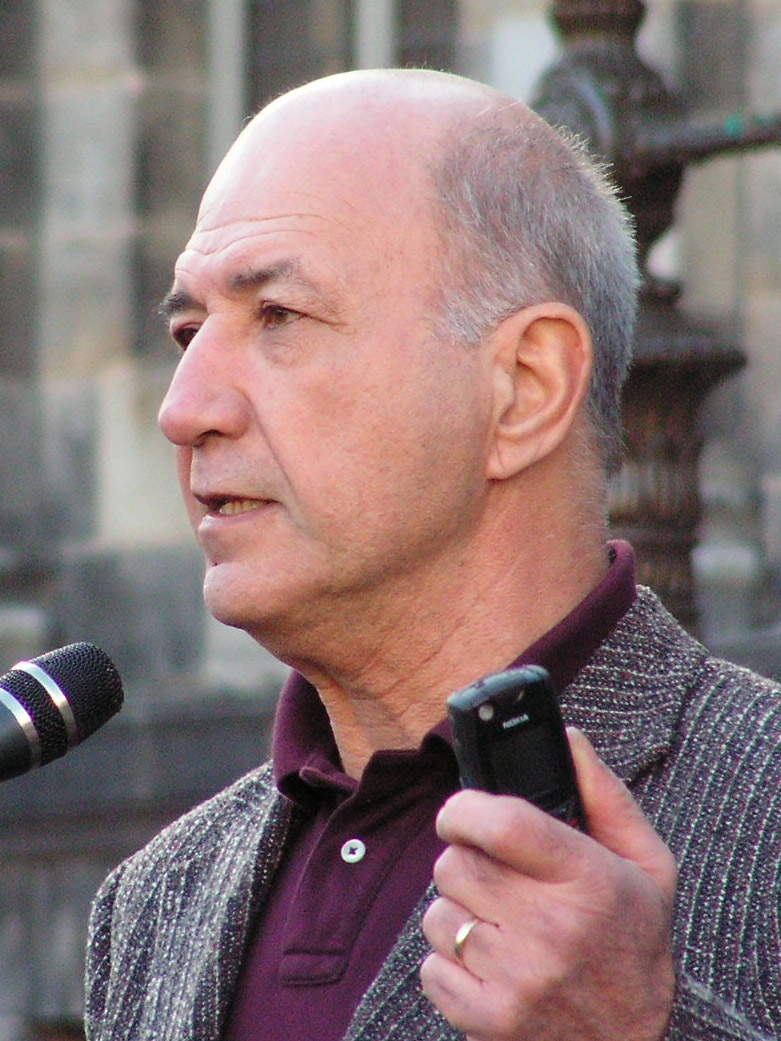- Wubbo Ockels
Infobox Astronaut
name =Wubbo Ockels

type =ESA Astronaut
nationality =Dutch
date_birth =March 28 ,1946
place_birth =Almelo ,The Netherlands
occupation =Physicist
selection =1978 ESA Group
time =7d 00h 44m
mission =STS-61-A
insignia =|Wubbo Johannes Ockels is a Dutch
physicist andastronaut . In 1985 he participated in a flight of the space shuttle, making him the first and only Dutch citizen in space, until the flight of Dutch astronautAndre Kuipers to the International Space Station in 2004. He is not the first Dutch-born astronaut, because he is preceded by the naturalized AmericanLodewijk van den Berg . Ockels is currently professor of "Aerospace for Sustainable Engineering and Technology" at theDelft University of Technology .Ockels was born
March 28 ,1946 , inAlmelo but considers Groningen to be his hometown. He received aPh.D. degree inphysics andmathematics from theUniversity of Groningen in 1978. His M.Sc. thesis was based on experimental work at the Nuclear Physics Accelerator Institute (K.V.I.) in Groningen in 1973.From 1973 to 1978, Ockels performed experimental investigations at the Nuclear Physics Accelerator Institute in Groningen. His work concerned the
gamma-ray decay of nuclear systems directly after formation and the development of a data-handling system involving design of electronics and programming ofreal-time software . He also contributed to the design and construction of position-sensitive charged particle detectors. While at the K.V.I. Institute, Ockels supervised the practical work of first-year physics students at the University of Groningen.Challenger mission
In 1978, he was selected by the
European Space Agency (ESA) as one of three European payload specialists to train for the Spacelab 1 mission. In May 1980, under agreement between ESA andNASA , Ockels and Swiss astronautClaude Nicollier were selected to begin the basic astronaut training for mission specialist together with the NASA astronaut candidates at NASA'sJohnson Space Center ,Houston, Texas . Ockels successfully completed this training in August 1981. He rejoined the Spacelab 1 crew for training as a back-up payload specialist to operate experiments aboard Spacelab 1. This mission of a reusable, scientific research facility built by the European Space Agency (ESA) took place aboard the Space Shuttle in November 1983. Spacelab 1 was a joint NASA/ESA mission. Having served his role as back-up payload specialist for German astronautUlf Merbold , he took his place in Mission Control in Houston as the primary communicator between the astronauts working in Spacelab and the Mission Management Team in Houston.Ockels flew as a payload specialist on the crew of STS-61A Challenger (
October 30 toNovember 6 ,1985 ). STS-61A was the West German D-1 Spacelab mission. It was the first to carry eight crew members, (five Americans, two Germans and Ockels); the largest to fly in space; and was also the first in which payload activities were controlled from outside the United States: from the DLR control center in Germany. More than 75 scientific experiments were completed in the areas of physiological sciences,materials science ,biology , andnavigation . At mission conclusion Ockels had traveled 2.5 million miles in 110 Earth orbits, and logged over 168 hours in space.A small
planetoid is named after Wubbo Ockels by theInternational Astronomical Union . The planetoid orbits the Sun betweenMars andJupiter . The object's full name is9496 Ockels .Ockels is a member of the
American Physical Society and theEuropean Physical Society . From 1999 to 2003, he was head ofESA 's Office for Educational Projects Outreach Activities.Ockels is married and has two children.
In August 2005, Ockels had a severe heart attack which required his hospitalization. He has recovered well from his illness and has resumed his work at the
Delft University of Technology . [http://www.expatica.com/source/site_article.asp?subchannel_id=19&story_id=23114&name=Former+Dutch+astronaut+in+hospital]cientific career
In 1992, Ockels was appointed part-time professor
Aerospace Engineering (in particular, Aerospace for Sustainable Engineering and Technology) at the Delft University of Technology, and promoted to full-time professor in September 2003. In this function, he has overseen theNuna projects. He has also proposed the development of a Superbus, a new method of high speed (250 km/hour)public transportation by road. The public transportation companyConnexxion is the first company to invest in the development of this Superbus. [http://www.tudelft.nl/live/pagina.jsp?id=30380163-f32c-4c33-a943-8512116edd8a&lang=nl] (news available in Dutch only).Currently Wubbo Ockels is involved in his "LadderMill"
sustainable energy program. ALaddermill is a kind ofwindmill consisting of a "ladder" of "kites". As quoted from his website: [http://www.ockels.nl/]The LadderMill is the response to the challenge for exploiting the gigantic energy source contained in the airspace up to high altitudes of 10 km. The concept has been developed with the aim to convert wind energy at altitude in electricity on the ground in an environmental and cost effective manner.
ee also
References
*"Portions of this article are based on
public domain text from [http://www.jsc.nasa.gov/Bios/htmlbios/ockels-wj.html NASA] ."
* [http://www.spacefacts.de/bios/international/english/ockels_wubbo.htm Spacefacts biography of Wubbo Ockels]External links
*nl icon [http://www.wubboockelsprijs.nl/ Wubbo Ockels prize]
Wikimedia Foundation. 2010.
